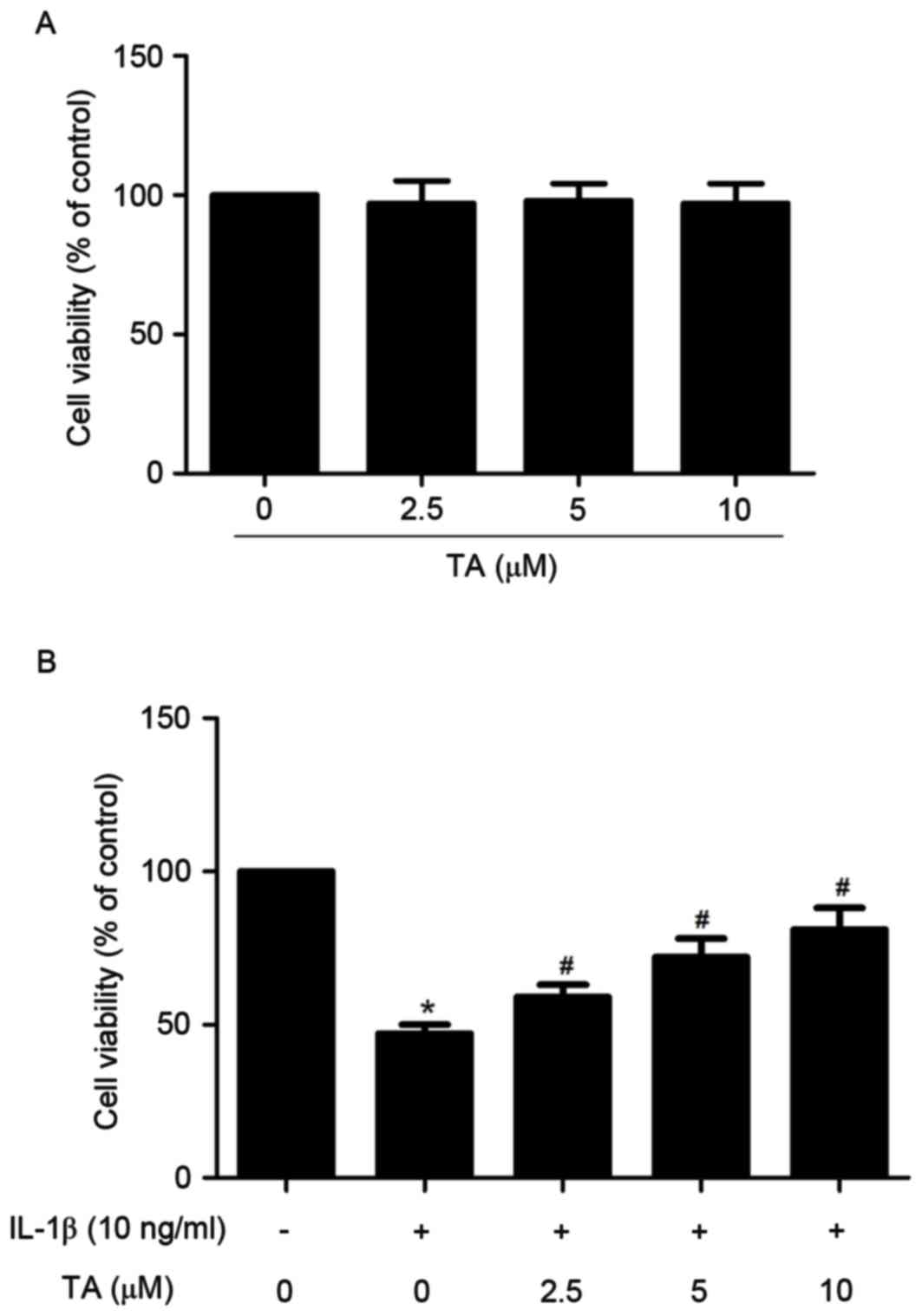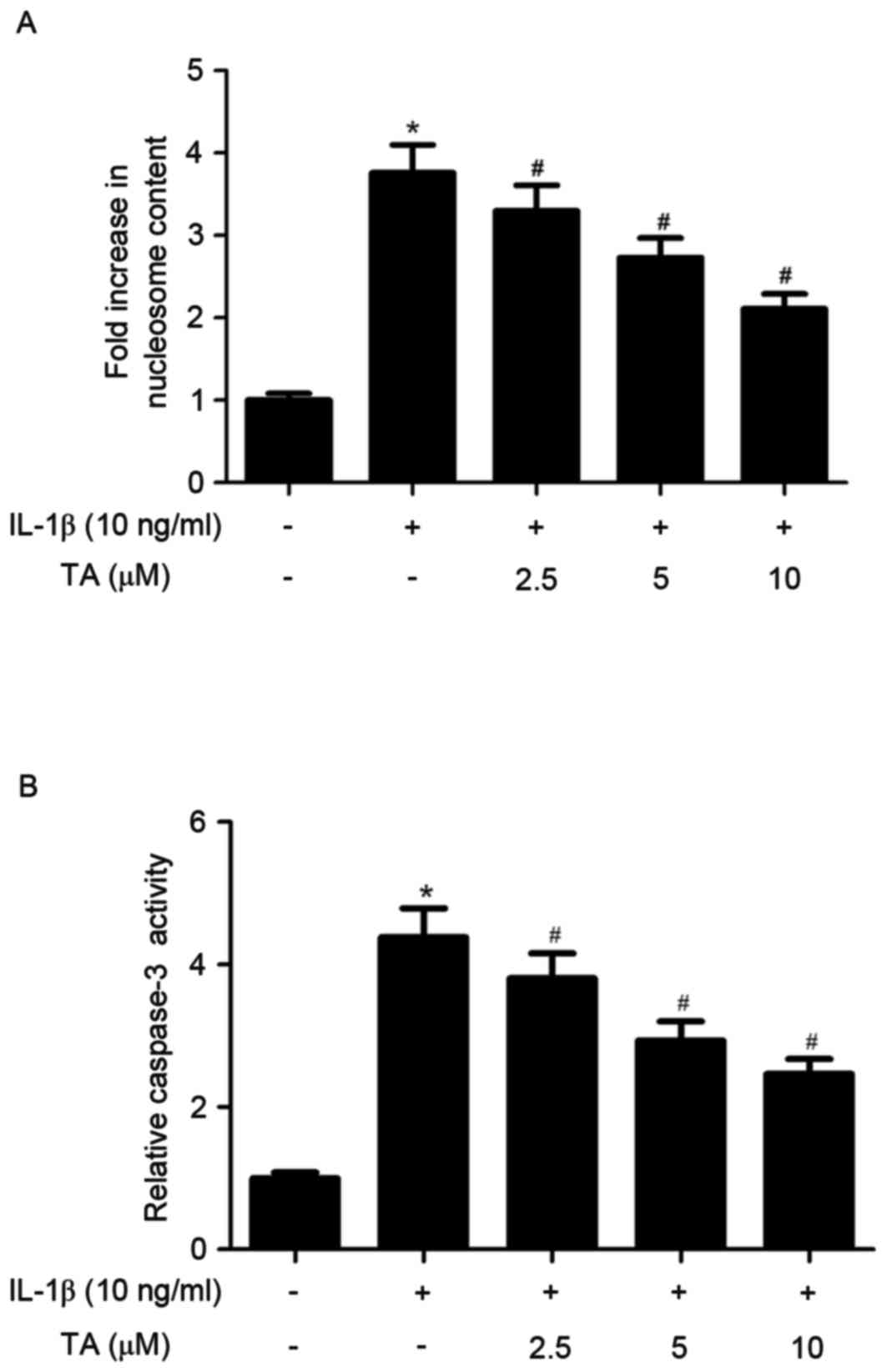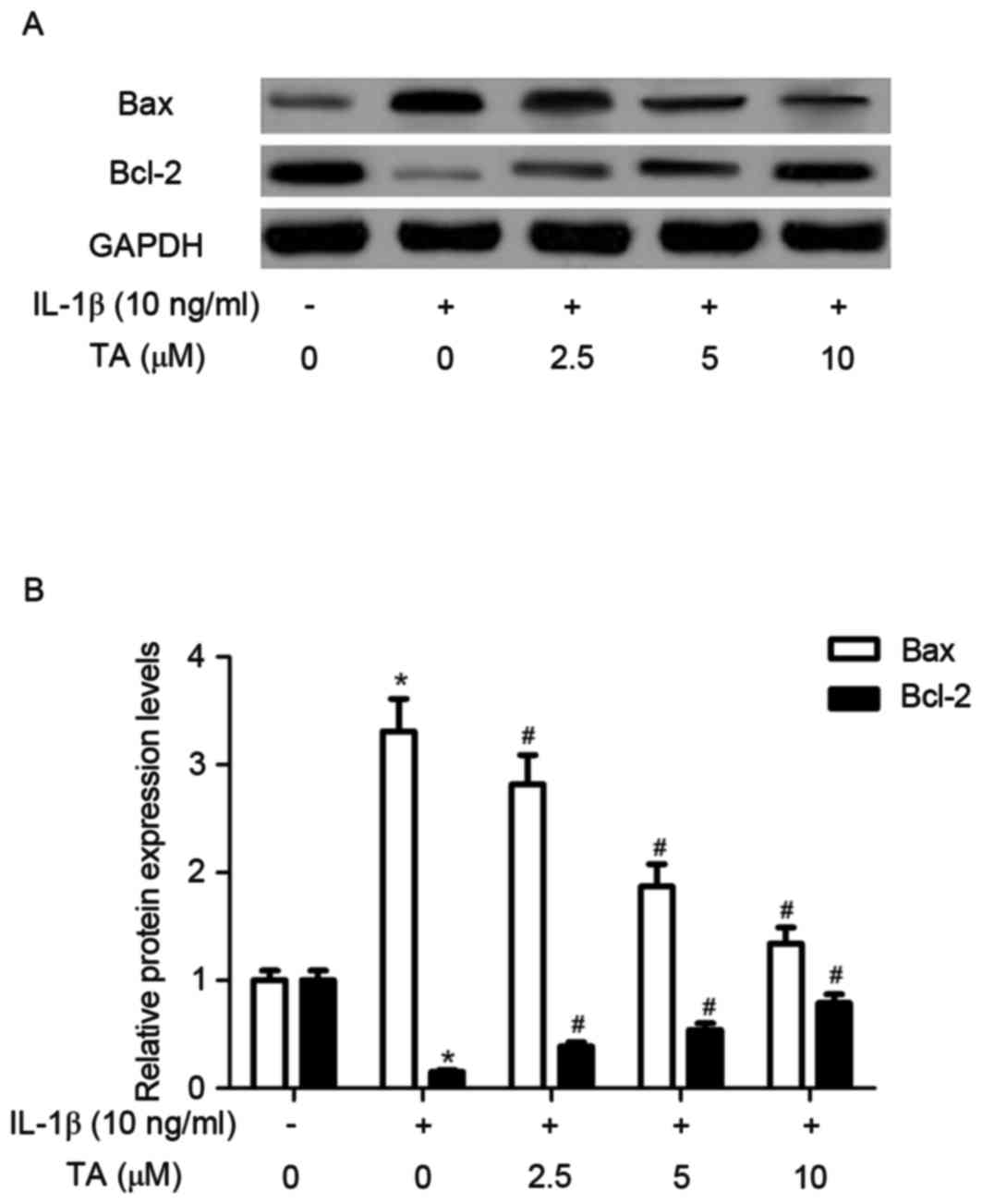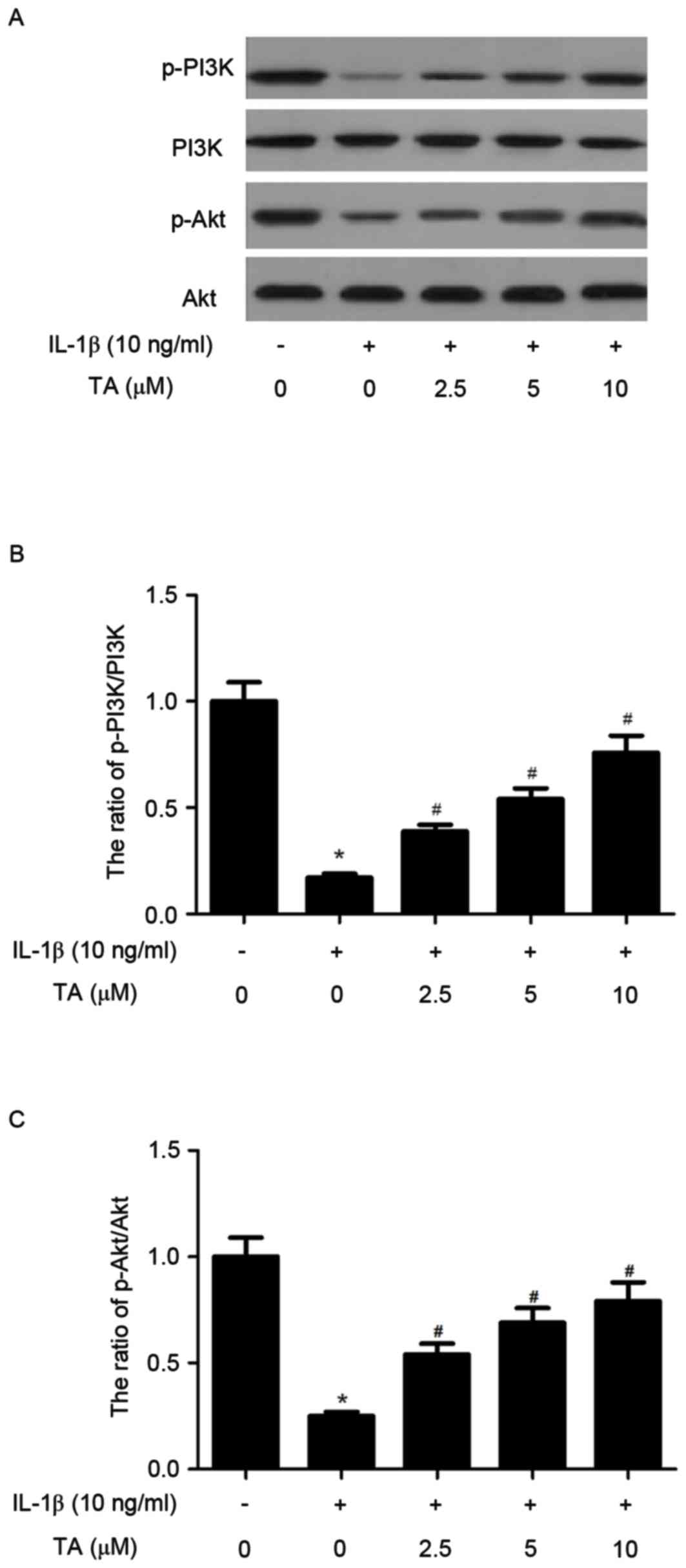Tormentic acid inhibits IL-1β-induced chondrocyte apoptosis by activating the PI3K/Akt signaling pathway
- Authors:
- Published online on: January 12, 2018 https://doi.org/10.3892/mmr.2018.8425
- Pages: 4753-4758
Abstract
Introduction
Osteoarthritis is a common arthritic disease in the elderly, which is characterized by progressive destruction of articular cartilage, synovial inflammation, subchondral bone exposure and the formation of osteophytes (1). Although some drugs have been demonstrated to reduce symptoms and slow the progression of osteoarthritis, there are currently no effective pharmacological treatments available to cure osteoarthritis.
Chondrocytes are the only cells that form the articular cartilage; therefore, apoptosis of chondrocytes is a critical step in the pathogenesis of osteoarthritis (2). Previous studies have revealed that osteoarthritic chondrocytes exhibit a loss of mitochondrial function, which precedes the classical signs of apoptosis (3–5). Interleukin-1β (IL-1β) is a cytokine secreted by synovial cells and macrophages, which serves an important role in amplifying inflammation in osteoarthritis (6,7). In response to IL-1β, chondrocytes secrete proinflammatory cytokines, chemokines, neutral metalloproteinases and nitric oxide (NO) (8). IL-1β has previously been demonstrated to increase apoptosis in osteoarthritic chondrocytes (9,10).
Tormentic acid (TA), which is a triterpene isolated from the stem bark of the Vochysia divergens plant, has been reported to exhibit anticancer, antioxidant, anti-inflammatory and antiallodynic properties (11–13). An et al (14) reported that TA inhibited the expression of lipopolysaccharide-induced tumor necrosis factor (TNF)-α, inducible NO synthase and cyclooxygenase 2 in RAW264.7 cells. In addition, TA has exhibited in vitro inhibitory activity against hepatocyte apoptosis by decreasing the levels of cytochrome c, as well as caspases-3, −8 and −9 (15). However, the effects of TA on IL-1β-induced apoptosis of human chondrocytes remain unclear. Therefore, the present study investigated the in vitro effects of TA on the apoptosis of IL-1β-treated human osteoarthritic chondrocytes.
Materials and methods
Culture of human articular cartilage chondrocytes
Chondrocytes were isolated from cartilage as previously described (16). The cartilage was dissected and crushed into small pieces. The slices were digested primarily with 1% pronase (Sigma-Aldrich; Merck KGaA, Darmstadt, Germany) for 2 h at 37°C and subsequently with 0.2% (v/v) collagenase (Sigma-Aldrich; Merck KGaA) for 4 h at 37°C. Primary chondrocytes were cultured in Dulbecco's Modified Eagle Medium (DMEM; Invitrogen; Thermo Fisher Scientific, Inc., Waltham, MA, USA) supplemented with 10% fetal bovine serum (FBS; Invitrogen; Thermo Fisher Scientific, Inc.), 100 U/ml penicillin and 100 mg/ml streptomycin(Sigma-Aldrich; Merck KGaA) at 1×106 cells/ml in a 25-cm2 plastic culture flask at 37°C in an atmosphere containing 5% CO2. Once cells reached 80% confluence, they were passaged; chondrocytes from passage one were used for subsequent experiments. Cartilage samples were derived from eight patients (female; age, 64.3±5.2 years) with end-stage osteoarthritisin Tianjin Hospital between May 2014 and October 2015. Informed written consent was obtained from patients and the present study was approved by the Ethics Committee of Tianjin Hospital (Tianjin, China).
Cell treatment
Human chondrocytes (1×104 cells/well) in 96-well plates were pretreated with various concentrations (2.5, 5 and 10 µM) of TA (Sigma-Aldrich; Merck KGaA) for 2 h and then co-incubated in the absence or presence of IL-1β (10 ng/ml; Sigma-Aldrich; Merck KGaA) for 24 h at 37°C. Chondrocytes exposed to medium alone at room temperature served as the control group.
Cell viability assay
A 3-(4,5-dimethylthiazol-2-yl)-2,5-diphenyltetrazolium bromide (MTT) assay was used to detect cell viability. Briefly, chondrocytes at a density of 1×104 cells/well were plated in 96-well culture plates. Following treatment, MTT was added to the cells at a final concentration of 0.5 mg/ml and incubated for 4 h at 37°C. Subsequently, the supernatant was removed, and the crystals were dissolved in 100 µl dimethyl sulfoxide (Sigma-Aldrich; Merck KGaA). The absorbance was measured at 490 nm using a Bio-Rad microplate reader (Bio-Rad Laboratories Inc., Hercules, CA, USA).
Nucleosome ELISA assay for the detection of apoptosis. The apoptosis of human chondrocytes was detected using a Nucleosome ELISA kit (catalog no. KA1091; Abnova, Taipei, Taiwan) according to the manufacturer's protocol. Following treatment, chondrocytes were lysed in lysis buffer and the homogenates were centrifuged at 10,000 × g at 4°C for 30 min to remove large genomic DNA. The supernatant was added to ELISA plates coated with anti-histone antibodies and incubated with a peroxidase-conjugated anti-DNA antibody at 37°C for 1 h. Nucleosome detection was based on a colorimetric change in substrate added to the wells following conjugation.
Measurement of caspase activity
Caspase-3 activity was detected usingacaspase-3 colorimetric assay kit (catalog no. E13183; Invitrogen; Thermo Fisher Scientific, Inc.). Briefly, following treatment, chondrocytes were lysed in lysis buffer and centrifuged at 10,000 × g for 1 min, and the supernatants were collected. Subsequently, equal amounts of protein were reacted with the aminomethylcoumarin (AMC)-derived substrate Z-DEVD-AMC at 37°C for 90 min. The activity of caspase-3 was determined using a plate reader set at 405 nm.
Western blot analysis
Chondrocytes were lysed in 100 µl lysis buffer (1% Triton X-100, 1% deoxycholic acid, 20 mM NaCl and 25 mM Tris; pH 7.4). The cell lysate supernatants were harvested by centrifugation at 10,000 × g for 10 min at 4°C. Protein concentrations of the cell supernatants were measured using a bicinchoninic acid protein assay kit. Equal amounts of protein (30 µg) were separated by 12% SDS-PAGE and transferred onto a nitrocellulose membrane (Bio-Rad Laboratories, Inc.). Following blocking with 5% non-fat milk in Tris-buffered saline (TBS) with 0.1% Tween-20 (TBST) at room temperature for 1 h, the blots were incubated with primary antibodies overnight at 4°C. The following antibodies were used: Mouse anti-B-cell lymphoma (Bcl)-2 (dilution, 1:1,000; catalog no. sc-7382), mouse anti-Bcl-2-associated X protein (Bax; dilution, 1:1,000; catalog no. sc-7480), rabbit anti-phosphorylated (p)-phosphoinositide 3-kinase (PI3K; dilution, 1:1,500; catalog no. sc-293115), mouse anti-PI3K (dilution, 1:1,500; catalog no. sc-71892), mouse anti-p-protein kinase B(p-Akt; dilution, 1:1,000; catalog no. sc-52940), mouse anti-Akt (dilution, 1:1,000; catalog no. sc-5298) and mouse anti-GAPDH (dilution, 1:3,000; catalog no. sc-365062). All primary antibodies were purchased from Santa Cruz Biotechnology, Inc. (Dallas, TX, USA). Subsequently, the membranes were incubated with rabbit anti-mouse (dilution, 1:3,000; catalog no. 61–6520) or goat anti-rabbit (dilution, 1:3,000; catalog no. 65–6120) immunoglobulin G-horseradish peroxidase-labeled secondary antibodies(Invitrogen; Thermo Fisher Scientific, Inc.) at room temperature for 1 h. Finally, protein bands were visualized using an enhanced chemiluminescence kit (Amersham; GE Healthcare Life Sciences, Little Chalfont, UK). Semi-quantitative analysis was performed using Gel-Pro Analyzer version 4.0 software (Media Cybernetics, Inc., Rockville, MD, USA).
Statistical analysis
Data was analyzed using SPSS software version 13.0 (SPSS, Inc., Chicago, IL, USA). Results from at least three independent experiments were expressed as the mean ± standard deviation. Differences were analyzed using a Student's t-test or one-way analysis of variance followed by Tukey's posthoc test. P<0.05 was considered to indicate a statistically significant difference.
Results
Effects of TA on human chondrocyte viability
The effects of TA on IL-1β-stimulated human chondrocytes were evaluated using an MTT assay. As shown in Fig. 1A, human chondrocyte cell viability was unaffected by TA. Following incubation with IL-1β (10 ng/ml), cell viability was significantly decreased in human chondrocytes. However, when IL-1β-stimulated chondrocytes were pretreated with various doses of TA for 2 h, cell viability increased significantly (Fig. 1B).
TA suppresses IL-1β-induced apoptosis of chondrocytes
A Nucleosome ELISA assay was performed to measure the effects of TA on apoptosis of IL-1β-stimulated human chondrocytes. The results revealed that IL-1β treatment significantly induced chondrocyte apoptosis. However, TA pretreatment significantly inhibited apoptosis induced by IL-1β (Fig. 2A). Caspase-3 activity was also determined in the various groups using the caspase-3 colorimetric assay kit. As shown in Fig. 2B, TA significantly suppressed IL-1β-induced caspase-3 activation in human chondrocytes.
TA promotes anti-apoptotic protein and inhibits proapoptotic protein expression in chondrocytes
To evaluate whether TA modulates the expression of apoptosis-associated proteins, the effects of TA on Bax and Bcl-2 expression in IL-1β-stimulated human chondrocytes were investigated by western blot analysis. The results demonstrated that IL-1β significantly increased the expression of Bax protein and inhibited the expression of Bcl-2 protein. Conversely, in the TA-pretreated group, Bax expression was downregulated and the expression of Bcl-2 was upregulated in human chondrocytes (Fig. 3).
TA reduces IL-1β-induced apoptosis of human chondrocytes via the PI3K/Akt pathway
The present study also determined whether the PI3K/Akt pathway is associated with the protective effects of TA on IL-1β-induced apoptosis of human chondrocytes. As shown in Fig. 4, the expression levels of p-PI3K and p-Akt were significantly decreased following 24 h of IL-1β stimulation compared with the control group. However, pretreatment with TA for 2 h significantly increased p-PI3K and p-Akt expression in IL-1β-induced chondrocytes.
Discussion
It has previously been reported that there are significant associations between increasing chondrocyte apoptosis and the severity of osteoarthritis in in vitro and in vivo studies (17–19). Therefore, it is essential to elucidate the molecular mechanisms underlying chondrocyte apoptosis in osteoarthritis. The present study investigated the effects of TA on IL-1β-induced chondrocyte apoptosis, and revealed that TA promotes cell viability and inhibits cell apoptosis in IL-1β-stimulated human chondrocytes.
Proinflammatory cytokines, such as TNF-α and IL-1β, serve important roles in degenerative joint diseases including OA. Previous studies have demonstrated that IL-1β promotes the imbalance between excessive cartilage destruction and cartilage repair (20,21). IL-1β has been widely used to mimic the osteoarthritic microenvironment in in vitro studies (22). In the present study, IL-1β-induced human chondrocytes were chosen as a model to study the protective effects of TA on chondrocytes. A significant decrease in cell viability was observed in IL-1β-stimulated chondrocytes. However, when TA was added to IL-1β-treated chondrocytes, there was a significant restoration in chondrocyte viability.
Chondrocyte apoptosis is responsible for the development and progression of osteoarthritis. During the progression of osteoarthritis, apoptotic cells are the main source of numerous catabolic factors, including proteases, proinflammatory mediators, NO and oxygen radicals (23,24). The present study demonstrated that IL-1β treatment significantly induced chondrocyte apoptosis. These in vitro observations are consistent with previous reports, which revealed that IL-1β suppresses viability and induces apoptotic signaling in human chondrocytes harvested from articular cartilage and osteoarthritic cartilage (4,25). However, TA pretreatment markedly inhibited apoptosis induced by IL-1β.
Caspases area family of cysteine proteases, which act as common death effector molecules in several apoptotic pathways (26). A previous study reported that caspase-3 activity is markedly enhanced in chondrocyte apoptosis induced by IL-1β (27). In addition, the Bax/Bcl-2 family consists of many important regulators of apoptosis; therefore, alterations in the levels of anti- and proapoptotic proteins mayaffect the apoptotic process (28,29). The present study revealed that TA markedly suppressed caspase-3 activity induced by IL-1β in human chondrocytes, and downregulated Bax expression and upregulated Bcl-2 expression in IL-1β-stimulated human chondrocytes. These results indicated that TA exhibited protective effects on human chondrocytes in the presence of IL-1β by inhibiting chondrocyte apoptosis.
Previous studies have suggested that the PI3K/Akt signaling pathway may be involved in the regulation of chondrocyte apoptosis (30–32). p-Akt activates the Bcl-2-associated death promoter protein, a downstream substrate of Akt, leading to the release of Bcl-2 and subsequently, the inhibition of apoptosis (33). Conversely, suppression of PI3K/Akt signaling blocks proteoglycan synthesis in chondrocytes and reduces chondrocyte survival (34,35). The present study demonstrated that pretreatment with TA for 2 h markedly increased p-PI3K and p-Akt expression in chondrocytes treated with IL-1β. These results indicated that TA may inhibit IL-1β-induced chondrocyte apoptosis via activation of the PI3K/Akt signaling pathway.
In conclusion, the results of the present study suggested that TA attenuated IL-1β-induced apoptosis via activation of the PI3K/Akt signaling pathway in human chondrocytes. Therefore, TA may be a potential therapeutic target for the treatment of osteoarthritis.
Acknowledgements
The present study was funded by the Tianjin Hospital Science Foundation (grant no. TJYY1601) and by the National Natural Science Foundation of China (grant no. 81702208 and 81501919).
References
|
Martel-Pelletier J: Pathophysiology of osteoarthritis. Osteoarthr Cartilage. 12 Suppl A:S31–S33. 2014. View Article : Google Scholar | |
|
Johnson E, Charchandi A, Babis G and Soucacos P: Apoptosis in osteoarthritis: Morphology, mechanisms, and potential means for therapeutic intervention. J Surg Orthop Adv. 17:147–152. 2007. | |
|
Grishko V, Xu M, Ho R, Mates A, Watson S, Kim JT, Wilson GL and Pearsall AW IV: Effects of hyaluronic acid on mitochondrial function and mitochondria-driven apoptosis following oxidative stress in human chondrocytes. J Biol Chem. 284:9132–9139. 2009. View Article : Google Scholar : PubMed/NCBI | |
|
Dave M, Attur M, Palmer G, Al-Mussawir HE, Kennish L, Patel J and Abramson SB: The antioxidant resveratrol protects against chondrocyte apoptosis via effects on mitochondrial polarization and ATP production. Arthritis Rheum. 58:2786–2797. 2008. View Article : Google Scholar : PubMed/NCBI | |
|
Blanco FJ, Rego I and Ruiz-Romero C: The role of mitochondria in osteoarthritis. Nat Rev Rheumatol. 7:161–169. 2011. View Article : Google Scholar : PubMed/NCBI | |
|
Goldring MB: Osteoarthritis and cartilage: The role of cytokines. Curr Rheumatol Rep. 2:459–465. 2000. View Article : Google Scholar : PubMed/NCBI | |
|
Bassleer CT, Combal JP, Bougaret S and Malaise M: Effects of chondroitin sulfate and interleukin-1 beta on human articular chondrocytes cultivated in clusters. Osteoarthr Cartilage. 6:196–204. 1998. View Article : Google Scholar | |
|
Daheshia M and Yao JQ: The interleukin 1 beta pathway in the pathogenesis of osteoarthritis. J Rheumatol. 35:2306–2312. 2008. View Article : Google Scholar : PubMed/NCBI | |
|
Yasuhara R, Miyamoto Y, Akaike T, Akuta T, Nakamura M, Takami M, Morimura N, Yasu K and Kamijo R: Interleukin-1beta induces death in chondrocyte-like ATDC5 cells through mitochondrial dysfunction and energy depletion in a reactive nitrogen and oxygen species-dependent manner. Biochem J. 389:315–323. 2005. View Article : Google Scholar : PubMed/NCBI | |
|
Sanchez C, Deberg MA, Piccardi N, Msika P, Reginster JY and Henrotin YE: Osteoblasts from the sclerotic subchondral bone downregulate aggrecan but upregulate metalloproteinases expression by chondrocytes. This effect is mimicked by interleukin-6,-1beta and oncostatin M pre-treated non-sclerotic osteoblasts. Osteoarthr Cartilage. 13:979–987. 2005. View Article : Google Scholar | |
|
Banno N, Akihisa T, Tokuda H, Yasukawa K, Higashihara H, Ukiya M, Watanabe K, Kimura Y, Hasegawa J and Nishino H: Triterpene acids from the leaves of Perilla frutescens and their anti-inflammatory and antitumor-promoting effects. Biosci Biotech Biochem. 68:85–90. 2004. View Article : Google Scholar | |
|
Song YL, Zhang L, Gao JM, Du GH and Cheng YX: Speciosaperoxide, a new triterpene acid, and other terpenoids from Chaenomeles speciosa. J Asian Nat Prod Res. 10:217–222. 2008. View Article : Google Scholar : PubMed/NCBI | |
|
Bortalanza LB, Ferreira J, Hess SC, Delle Monache F, Yunes RA and Calixto JB: Anti-allodynic action of the tormentic acid, a triterpene isolated from plant, against neuropathic and inflammatory persistent pain in mice. Eur J Pharmacol. 453:203–208. 2002. View Article : Google Scholar : PubMed/NCBI | |
|
An HJ, Kim IT, Park HJ, Kim HM, Choi JH and Lee KT: Tormentic acid, a triterpenoid saponin, isolated from Rosa rugosa, inhibited LPS-induced iNOS, COX-2, and TNF-α expression through inactivation of the nuclear factor-κb pathway in RAW 264.7 macrophages. Int Immunopharmacol. 11:504–510. 2011. View Article : Google Scholar : PubMed/NCBI | |
|
Lin X, Zhang S, Huang R, Tan S, Liang S, Wu X, Zhuo L and Huang Q: Protective effect of tormentic acid from Potentilla chinensis against lipopolysaccharide/D-galactosamine induced fulminant hepatic failure in mice. Int Immunopharmacol. 19:365–372. 2014. View Article : Google Scholar : PubMed/NCBI | |
|
Shakibaei M and Merker HJ: beta1-Integrins in the cartilage matrix. Cell Tissue Res. 296:565–573. 1999. View Article : Google Scholar : PubMed/NCBI | |
|
Aigner T and Kim HA: Apoptosis and cellular vitality: Issues in osteoarthritic cartilage degeneration. Arthritis Rheum. 46:1986–1996. 2002. View Article : Google Scholar : PubMed/NCBI | |
|
Goldring MB: Update on the biology of the chondrocyte and new approaches to treating cartilage diseases. Best Pract Res Clin Rheumatol. 20:1003–1025. 2006. View Article : Google Scholar : PubMed/NCBI | |
|
Mistry D, Oue Y, Chambers MG, Kayser MV and Mason RM: Chondrocyte death during murine osteoarthritis. Osteoarthr Cartilage. 12:131–141. 2004. View Article : Google Scholar | |
|
Caron JP, Fernandes JC, Martel-Pelletier J, Tardif G, Mineau F, Geng C and Pelletier JP: Chondroprotective effect of intraarticular injections of interleukin-1 receptor antagonist in experimental osteoarthritis. Suppression of collagenase-1 expression. Arthritis Rheum. 39:1535–1544. 1996. View Article : Google Scholar : PubMed/NCBI | |
|
Joosten LA, Helsen MM, Saxne T, van De Loo FA, Heinegard D and van Den Berg WB: IL-1alpha beta blockade prevents cartilage and bone destruction in murine type II collagen-induced arthritis, whereas TNF-alpha blockade only ameliorates joint inflammation. J Immunol. 163:5049–5055. 1999.PubMed/NCBI | |
|
Largo R, Alvarez-Soria M, Dıez-Ortego I, Calvo E, Sanchez-Pernaute O, Egido J and Herrero-Beaumont G: Glucosamine inhibits IL-1beta-induced NFkappaB activation in human osteoarthritic chondrocytes. Osteoarthritis Cartilage. 11:290–298. 2003. View Article : Google Scholar : PubMed/NCBI | |
|
Mazzetti I, Grigolo B, Pulsatelli L, Dolzani P, Silvestri T, Roseti L, Meliconi R and Facchini A: Differential roles of nitric oxide and oxygen radicals in chondrocytes affected by osteoarthritis and rheumatoid arthritis. Clin Sci. 101:593–599. 2001. View Article : Google Scholar : PubMed/NCBI | |
|
Venkatesan N, Barre L, Benani A, Netter P, Magdalou J, Fournel-Gigleux S and Ouzzine M: Stimulation of proteoglycan synthesis by glucuronosyltransferase-I gene delivery: A strategy to promote cartilage repair. Proc Natl Acad Sci USA. 101:pp. 18087–18092. 2004; View Article : Google Scholar : PubMed/NCBI | |
|
Wang L, Gai P, Xu R, Zheng Y, Lv S, Li Y and Liu S: Shikonin protects chondrocytes from interleukin-1beta-induced apoptosis by regulating PI3K/Akt signaling pathway. Int J Clin Exp Pathol. 8:2982015.PubMed/NCBI | |
|
Samali A, Zhivotovsky B, Jones D, Nagata S and Orrenius S: Apoptosis: Cell death defined by caspase activation. Cell Death Differ. 6:495–496. 1999. View Article : Google Scholar : PubMed/NCBI | |
|
Shakibaei M, Schulze-Tanzil G, John T and Mobasheri A: Curcumin protects human chondrocytes from IL-1beta-induced inhibition of collagen type II and beta1-integrin expression and activation of caspase-3: An immunomorphological study. Anna Anat. 187:487–497. 2005. View Article : Google Scholar | |
|
Chen J, Chu Y, Cao J, Yang Z, Guo X and Wang Z: T-2 toxin induces apoptosis, and selenium partly blocks, T-2 toxin induced apoptosis in chondrocytes through modulation of the Bax/Bcl-2 ratio. Food Chem Toxicol. 44:567–573. 2006. View Article : Google Scholar : PubMed/NCBI | |
|
Malemud CJ and Gillespie HJ: The role of apoptosis in arthritis. Curr Rheumatol Rev. 1:131–142. 2005. View Article : Google Scholar | |
|
Sugimori K, Matsui K, Motomura H, Tokoro T, Wang J, Higa S, Kimura T and Kitajima I: BMP-2 prevents apoptosis of the N1511 chondrocytic cell line through PI3K/Akt-mediated NF-kappaB activation. J Bone Miner Metab. 23:411–419. 2005. View Article : Google Scholar : PubMed/NCBI | |
|
Oh CD and Chun JS: Signaling mechanisms leading to the regulation of differentiation and apoptosis of articular chondrocytes by insulin-like growth factor-1. J Biol Chem. 278:36563–36571. 2003. View Article : Google Scholar : PubMed/NCBI | |
|
Ikegami D, Akiyama H, Suzuki A, Nakamura T, Nakano T, Yoshikawa H and Tsumaki N: Sox9 sustains chondrocyte survival and hypertrophy in part through Pik3ca-Akt pathways. Development. 138:1507–1519. 2011. View Article : Google Scholar : PubMed/NCBI | |
|
Stiles BL: PI-3-K and AKT: Onto the mitochondria. Adv Drug Deliver Rev. 61:1276–1282. 2009. View Article : Google Scholar | |
|
Yin W, Park JI and Loeser RF: Oxidative stress inhibits insulin-like growth factor-I induction of chondrocyte proteoglycan synthesis through differential regulation of phosphatidylinositol 3-Kinase-Akt and MEK-ERK MAPK signaling pathways. J Biol Chem. 284:31972–31981. 2009. View Article : Google Scholar : PubMed/NCBI | |
|
Starkman BG, Cravero JD, Delcarlo M and Loeser RF: IGF-I stimulation of proteoglycan synthesis by chondrocytes requires activation of the PI 3-kinase pathway but not ERK MAPK. Biochem J. 389:723–729. 2005. View Article : Google Scholar : PubMed/NCBI |













